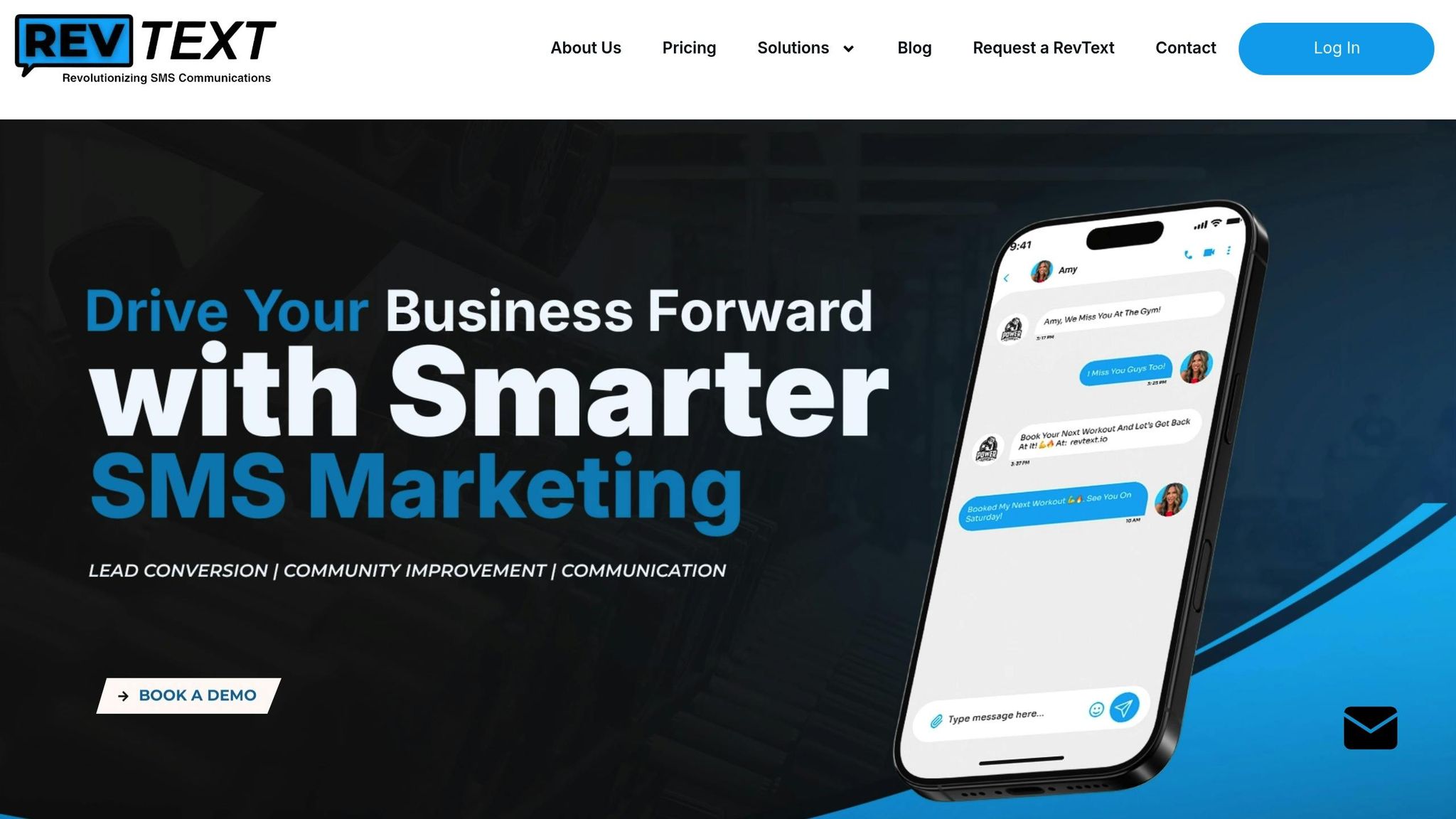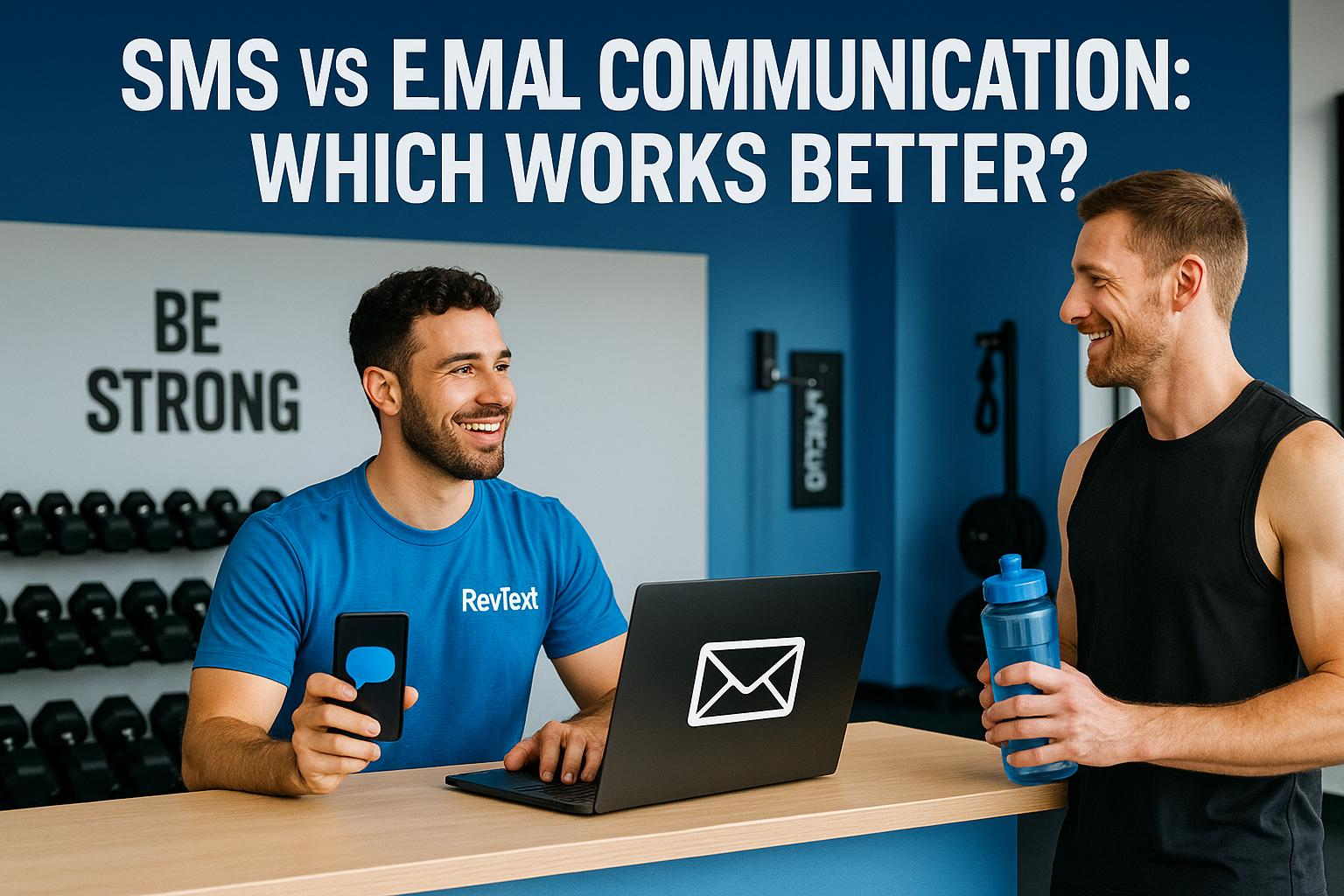SMS and email are both powerful tools for gym communication, but they serve different purposes. SMS is best for urgent updates like class reminders or flash deals, with a 98% open rate and most texts read within minutes. Email, on the other hand, excels at delivering detailed content such as newsletters, fitness tips, or event promotions, but only about 20% of recipients open them. Combining both channels effectively can boost member engagement and retention.
Key Takeaways:
- SMS Strengths: High open rates, quick responses, ideal for time-sensitive updates.
- Email Strengths: Great for detailed content, visuals, and building long-term relationships.
- Best Strategy: Use SMS for immediate action and email for in-depth communication. Together, they create a stronger, more effective communication strategy.
Quick Comparison:
| Metric | SMS | |
|---|---|---|
| Open Rate | ~98% | 20-39% |
| Response Time | Minutes | Hours to days |
| Click-Through Rate | 6-19% | 2.6-3% |
| Conversion Rate | Up to 29% | ~15% |
| Response Rate | Up to 45% | 6-7% |
| Unsubscribe Rate | <5% | ~20% annually |
For gyms, the smartest approach is combining SMS and email to maximize their unique strengths. SMS drives immediate action, while email builds deeper connections. Tools like RevText make implementing this strategy easier with features like member segmentation, prebuilt templates, and automated workflows.
SMS Communication Benefits for Fitness Businesses
High Open Rates and Quick Response Times
One of the biggest advantages of SMS is how quickly messages are read and acted upon. Most text messages are opened within minutes, making SMS perfect for time-sensitive updates. For example, if a class fills up unexpectedly or there’s a last-minute schedule change, members can be notified well before they’d even think to check their email. This sense of urgency also makes SMS ideal for flash promotions or limited-time offers, encouraging quick action. It’s a fast and efficient way to keep members informed and engaged.
When to Use SMS in Gyms
SMS is most effective for messages that need immediate attention. It’s great for sending class reminders or notifying members of schedule changes, helping reduce no-shows and keeping attendance steady. Flash promotions or limited-time deals also perform well through SMS, as the short, direct format motivates members to act quickly. Additionally, win-back campaigns can use SMS to re-engage lapsed members with a simple, personal message. For critical updates – like weather-related closures or urgent safety notices – SMS ensures members get the information they need without delay. By addressing these immediate needs, SMS helps gyms tackle common communication hurdles.
SMS Performance Data for Fitness
On top of its practical uses, SMS consistently delivers strong results. Many fitness businesses find it to be a cost-effective way to boost member engagement. Its reliability ensures that important updates, promotions, and reminders reach members without fail. Gyms using SMS often report higher engagement levels and faster responses from members, reinforcing how effective it can be in today’s competitive fitness industry. The data speaks for itself – SMS is a powerful tool for keeping members connected and informed.
Email Communication Benefits for Fitness Businesses
Best for Detailed and Visual Content
Email is an excellent platform for sharing detailed fitness tips, workout guides, and nutritional advice that members can refer back to whenever they need. Its visual capabilities make it ideal for showcasing your gym’s unique atmosphere. High-quality photos of group classes, inspiring before-and-after transformations, and highlights from recent events can all help bring your gym’s energy to life.
Monthly newsletters are particularly effective through email. They allow you to combine multiple pieces of content into one cohesive and engaging message. For example, you can include member spotlights, updates on upcoming events, announcements about new equipment, and details about seasonal fitness challenges. This format lets you provide clear pricing, descriptions, and visuals in a way that’s easy for members to digest.
Email is also a strong choice for promoting bundled offers. Instead of overwhelming members with multiple separate messages, you can present all your services or packages in a single, well-organized email. This approach not only simplifies communication but also helps members see the full value of what you’re offering, making it a key tool for long-term engagement.
When to Use Email in Gyms
Email shines when it comes to lead nurturing campaigns. Potential members often need time to make a decision, and email allows you to gradually introduce them to your gym’s culture, share success stories, and outline membership options over several weeks. This steady stream of information can build trust and encourage them to take the next step.
It’s also a great way to share educational content. Members appreciate receiving workout routines they can do at home, nutrition tips from your trainers, or advice on proper form for challenging exercises. This type of content not only keeps members engaged but also positions your gym as a go-to resource for fitness knowledge – even when they’re not on-site.
For event promotion and follow-up, email is a natural fit. Whether you’re hosting a fitness challenge, workshop, or community event, you can use email to share all the important details, registration links, and reminders in one convenient place. After the event, recap emails with photos and highlights can reinforce the positive experience and encourage participation in future activities. While email is powerful, it’s important to balance these strengths with its limitations.
Email Marketing Challenges
Despite its benefits, email marketing comes with its own set of challenges. For starters, email open rates average around 20%, which means a large portion of your audience might not even see your message. Another hurdle is response time – unlike SMS, which is often read within minutes, emails can sit unopened for hours or even days. This delay means your message might miss the ideal window for action.
The crowded inbox problem is another major obstacle. Between work emails, retail promotions, and personal messages, your gym’s emails can easily get buried. Even members who are genuinely interested in your content might overlook your message amidst the flood of daily emails. To stand out, your emails need to be eye-catching and highly relevant.
Finally, email requires more effort from your audience. Members have to open the email, scroll through the content, and often click a link to take action. Each of these steps creates opportunities for distraction or procrastination, which can lead to members deciding to “come back to it later” – and often never following through. Overcoming these hurdles requires thoughtful planning and a focus on creating emails that grab attention and drive immediate action.
SMS vs Email: Side-by-Side Comparison for Gyms
Performance Metrics Comparison
When it comes to performance, SMS consistently outshines email in almost every key metric. Here’s a quick breakdown:
| Metric | SMS | |
|---|---|---|
| Open Rate | ~98% | 20-39% |
| Response Time | Within minutes | Hours to days |
| Click-Through Rate | 6-19% | 2.6-3% |
| Conversion Rate | Up to 29% | ~15% |
| Response Rate | Up to 45% | 6-7% |
| Unsubscribe Rate | <5% | ~20% annually |
These numbers aren’t just stats – they directly influence your gym’s success. For example, if you send a class reminder via SMS, nearly everyone will see it, and most will read it within 90 seconds. On the other hand, an email might only reach about 20-39% of your audience, and it could sit unopened for hours or even days.
SMS also drives higher conversion rates, making it a powerful tool for actions like sign-ups or event RSVPs. With these metrics in mind, it’s clear that the channel you choose can make a big difference depending on your gym’s marketing goals.
Which Channel Works for Each Goal
Beyond the numbers, the effectiveness of SMS or email depends on the situation. Each has its strengths:
- SMS for Immediate Action: Need to send a class reminder 30 minutes before start time? SMS is your go-to. Its real-time nature ensures members see and act on it quickly.
- SMS for Re-engagement: Trying to win back lapsed members? SMS can be a game-changer. Even members who’ve ignored your emails for months are likely to open a well-crafted text offering a special deal or incentive.
- Email for Relationship Building: Email works best when you need to provide more detail. Lead nurturing campaigns, for instance, benefit from the space email offers to explain membership perks, class schedules, and your gym’s community vibe.
- Email for Educational Content: Sharing workout tips, nutrition advice, or member success stories? Email is the perfect platform for newsletters or bundled offers that require more context and explanation.
Pros and Cons of Each Channel
Understanding the strengths and limitations of SMS and email can help you make smarter choices for your gym’s communication strategy.
- Why SMS Stands Out: With sky-high open rates and lightning-fast response times, SMS is perfect for time-sensitive messages. Members check their phones often, so your message gets seen quickly. Plus, SMS can deliver a return on investment as high as 45:1, making it a cost-effective option despite its higher per-message cost. However, SMS has its challenges. The 160-character limit means you can’t include detailed information or multiple offers. Costs can add up for large campaigns, and compliance with regulations like TCPA and 10DLC adds an extra layer of complexity.
- Why Email Excels: Email offers unmatched flexibility. You can include images, detailed descriptions, and multiple calls-to-action in one message, all at a much lower cost per message than SMS. It’s ideal for newsletters, promotions, and any communication that isn’t time-sensitive. But email’s performance metrics leave much to be desired. With only 20% of recipients opening emails, it’s not ideal for urgent messages. Plus, an annual unsubscribe rate of around 20% means you’ll need to constantly refresh your list to maintain engagement.
A Multi-Channel Approach Works Best
The smartest gyms combine SMS and email to get the best of both worlds. Studies show that members who receive both SMS and email are 2.4 times more likely to make a purchase than those who only get SMS. By using each channel strategically, you can maximize their strengths while minimizing their drawbacks, ensuring your gym’s communication is both effective and efficient.
Using SMS and Email Together for Better Results
How to Coordinate SMS and Email Campaigns
Boost your gym’s communication strategy by combining the strengths of SMS and email. Each channel serves a distinct purpose, and when used together, they enhance each other’s impact.
SMS is ideal for quick, time-sensitive updates. For example, you can send reminders 30 minutes before a class, notify members about sudden schedule changes, or promote flash deals that expire within hours. With an impressive open rate of 97–98%, SMS ensures your message gets seen almost immediately.
Email, on the other hand, is perfect for sharing detailed content that builds lasting relationships. Use it for monthly newsletters filled with fitness tips, event recaps, or breakdowns of new membership packages. While email open rates are lower, it gives you the space to tell your story and showcase your gym’s personality.
The trick lies in timing and sequencing. Start with email to share detailed information, then follow up with SMS to drive immediate action. For instance, you could email a newsletter about upcoming group fitness classes, complete with descriptions and instructor bios. A few days later, send an SMS reminder like, "Don’t forget – Zumba starts in 2 hours! See you there 💪"
This combination creates a seamless communication flow, which is explored further in the next section.
Real Examples of Combined Campaigns
Here are practical ways to align your SMS and email campaigns for maximum impact:
- Fitness Challenge Launch: Kick off with an email introducing a 30-day challenge. Include details like rules, prizes, and inspiring success stories. As the deadline nears, send an SMS alert: "Only 3 spots left in our 30-Day Challenge! Sign up now before we’re full 🔥"
- Class Reminders: Start the week with an email sharing the full class schedule, special events, and instructor highlights. Follow up with SMS reminders on the day of the class, like: "Your yoga class starts in 1 hour. Can’t wait to see you on the mat!"
- Win-Back Campaign: Reconnect with inactive members by pairing email and SMS. Begin with an email offering an enticing incentive, such as a free personal training session or guest pass. A week later, follow up with an SMS: "We miss you! Your free PT session expires Friday. Book now: [link]"
- Flash Sale Promotion: Use SMS to grab attention quickly, then reinforce the offer with a detailed email. For example, send an SMS: "Flash Sale! 50% off personal training – today only!" Then follow up with an email explaining the sale, including trainer profiles and booking instructions.
Why a Multi-Channel Approach Works
Combining SMS and email isn’t just effective – it’s essential for modern gym communication. Research shows that multi-channel subscribers are 2.4 times more likely to make a purchase. Plus, 85% of consumers opt into both SMS and email from brands they trust. Offering both channels ensures you cater to different preferences – some members value SMS for its immediacy, while others prefer the depth of email.
This approach also guarantees important updates don’t go unnoticed. If a member misses an email about a schedule change, an SMS can fill the gap. Conversely, if they miss a text during a busy day, the detailed email can catch them up.
From a business perspective, this strategy boosts retention and lifetime value. SMS keeps members engaged with timely updates and reminders, reducing no-shows and increasing attendance. Meanwhile, email helps deepen connections by sharing stories and content that foster loyalty within your gym community.
sbb-itb-9f7e00b
RevText SMS Marketing Solutions for Gyms

Features Built for Fitness Businesses
RevText was created specifically with gyms and fitness studios in mind. One standout feature is member segmentation, which lets you organize members based on factors like how often they attend, their membership type, or their engagement history. This makes it easy to send tailored messages – like offering a special deal to members who haven’t shown up in the past 30 days or providing helpful onboarding tips to new members.
The platform also comes with prebuilt SMS templates designed for common gym scenarios. Whether you need to send class reminders, schedule updates, flash promotions, seasonal challenges, or win-back campaigns, these templates save you time and are optimized to get high open and response rates. No need to start from scratch every time you want to communicate with your members.
RevText takes compliance seriously. It automatically handles opt-ins, opt-outs, and consent tracking to ensure your SMS campaigns follow TCPA and 10DLC regulations. This not only protects your gym from potential legal issues but also helps build trust with your members.
Another plus? RevText integrates seamlessly with many popular gym CRMs and email marketing tools. This means your member data stays synced across platforms, allowing you to trigger SMS reminders based on CRM actions – like sending a class reminder when someone books through your system. These features make your marketing efforts more efficient and automated, helping your gym stay ahead.
Automated Campaigns and Optimization
RevText takes the hassle out of SMS marketing with automated workflows. These workflows send messages triggered by specific member actions – like missing a class or approaching a membership renewal date – so you don’t have to manage everything manually.
Since SMS is known for its real-time impact, these automated workflows ensure no opportunity slips through the cracks. To make things even better, RevText offers weekly optimization sessions. During these sessions, they review your campaign results and provide actionable recommendations to improve open rates, response rates, and conversions, helping you get the most out of your marketing efforts.
Here’s an example: A mid-sized fitness studio used RevText’s segmentation and automated reminders to reconnect with inactive members. They sent personalized "We Miss You" messages with limited-time discounts, which led to a 25% reactivation rate – more than double the less than 10% they achieved with email-only campaigns.
The platform also includes detailed analytics dashboards that track open rates, response rates, click-through rates, and conversions. These insights let you see which messages are driving the most engagement and revenue, so you can fine-tune your strategy for even better results.
Pricing Plans for Different Gym Sizes
RevText offers flexible pricing plans designed to fit gyms of all sizes. Here’s a breakdown:
- The Start Up plan costs $50 per month and includes 500 SMS messages, making it a great choice for boutique studios with up to 250 contacts that are just starting with SMS marketing.
- The Business plan is $90 per month and supports up to 500 contacts with 1,000 SMS messages. It also includes a rollover feature, so any unused messages carry over to the next month.
- For larger gyms, the Pro plan at $300 per month offers 5,000 SMS messages with rollover and supports up to 2,500 contacts.
- The Premium plan costs $500 per month, providing 10,000 SMS messages and accommodating up to 5,000 contacts.
All plans include core features like member segmentation, prebuilt templates, compliance tools, and CRM integrations. Higher-tier plans add advanced analytics and dedicated support. For gyms with specific needs, custom pricing options are also available, ensuring that every business can find a plan that works for them. With SMS consistently outperforming email, these plans offer a direct way to boost member engagement and retention.
Conclusion: Choosing the Right Channel for Your Gym
Key Takeaways for Gym Owners
Success in communication comes down to knowing when to use SMS and when to rely on email. For instance, SMS boasts an impressive 98% open rate and up to 45% response rate – making it perfect for urgent updates like class cancellations or flash promotions. On the other hand, email, with its 20% open rate, is ideal for more detailed content like newsletters, fitness tips, event recaps, or bundled promotions.
Think of email as your tool for storytelling and building deeper connections with your members, while SMS is your go-to for quick, time-sensitive communication. By combining the strengths of both channels, you can maximize your reach and impact. In fact, gym members who receive both SMS and email are 2.4 times more likely to make a purchase. With 85% of consumers already subscribing to both types of messages, the opportunity for a multi-channel strategy is right at your fingertips.
Now, let’s see how RevText can help you bring this strategy to life.
Why Choose RevText?
RevText simplifies your gym’s communication game with affordable plans ranging from $50 to $500 per month, catering to gyms and studios of all sizes.
With fitness-specific tools like member segmentation, prebuilt templates, and automated workflows, RevText takes the guesswork out of SMS marketing. Plus, built-in compliance and CRM integration mean you can focus on what matters most – keeping your members engaged.
Ready to take your gym’s communication to the next level? Book a free discovery call with RevText today. During your call, you’ll get personalized recommendations tailored to your gym’s unique needs. And with the average American checking their phone 96 times a day, your messages will land exactly when they’re needed most.
"SMS Marketing vs Email Marketing: Which One REALLY Works Best?"
FAQs
What’s the best way for gyms to combine SMS and email to boost member engagement and retention?
Gyms can effectively use SMS and email together by playing to the strengths of each platform. SMS is ideal for quick, time-sensitive messages, such as class reminders, last-minute schedule changes, or limited-time offers. Meanwhile, email shines when it comes to sharing more detailed information, like newsletters, fitness advice, or multi-offer promotions.
By combining these tools, gyms can craft a well-rounded communication plan. For instance, send a brief SMS to remind members about an upcoming class, then follow up with an email that provides the full schedule or extra details. This strategy not only keeps members engaged in the moment but also nurtures deeper connections over time.
How do I decide whether to use SMS or email for gym communications?
Choosing between SMS and email boils down to the urgency of your message and the type of content you’re sharing. SMS shines when you need to deliver time-sensitive updates – think class reminders, flash sales, or urgent announcements. Its impressive open rate of about 98% and quick response times make it perfect for grabbing attention fast.
Email, on the other hand, is better suited for detailed or visually engaging content. Whether it’s newsletters, fitness tips, or multi-offer promotions, email gives you the room to explain and connect on a deeper level.
For driving immediate action, SMS is the clear winner. But if you’re focused on nurturing relationships or keeping members engaged over time, email offers the space for those richer interactions. Combining both channels thoughtfully can help you boost engagement and drive conversions effectively.
How can combining SMS and email improve a gym’s marketing strategy and member conversions?
Combining SMS and email creates a dynamic marketing strategy by playing to the strengths of each channel. SMS is perfect for urgent updates like class reminders or limited-time promotions, thanks to its impressive open rate of about 98% and lightning-fast response times. Meanwhile, email shines when it comes to sharing more detailed content, such as newsletters, fitness advice, or multi-offer campaigns, fostering stronger, long-term connections with members.
By reserving SMS for immediate actions and using email for deeper engagement, gyms can effectively address varying member preferences while achieving diverse marketing objectives. This thoughtful mix not only keeps members engaged but also drives conversions and strengthens retention by ensuring the right message reaches them at just the right moment.




